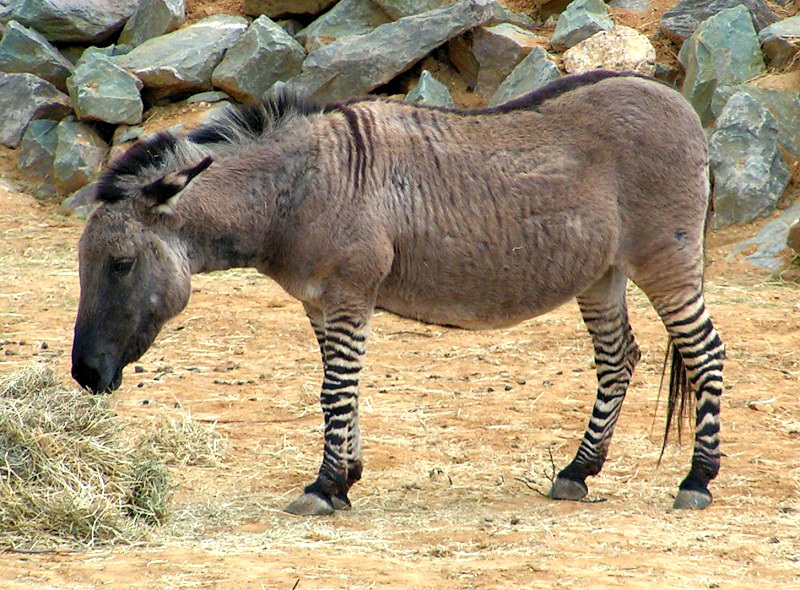|
| 질의: Draft horse | 결과: 9번째/15 | |
Zebroid - Wiki
| 제목: | Zebroid - Wiki
| | 올린이: | funny (from@wikipedia.org)
| |

| 해상도: 800x590
파일크기: 242488 Bytes
촬영일: 2007:09:15 00:58:44
등록시간: 2007:09:15 01:05:01
|
Zebroid
From Wikipedia, the free encyclopedia
[Photo] A donkey / zebra hybrid (called a "Zeedonk" by Colchester Zoo in England and a called a "zonkey" or "zedonk" elsewhere). Photo by sannse(http://en.wikipedia.org/wiki/User:Sannse), Colchester Zoo, 2 June 2004.
A zebroid is a cross between a zebra and any other equid: essentially, a zebra hybrid. They are also known as zebra mules and zebrules. In general, the sire is a zebra stallion. Offspring of a donkey sire and zebra mare, called a zebra hinny, do exist but are rare. Zebroids have been bred since the 19th Century. The extinct quagga was also crossed with horses and donkeys. Charles Darwin noted several zebra hybrids in his works.
Types of Zebroid
Zebroid is the generic name for all of the zebra hybrids. The different hybrids are generally named using the portmanteau convention of sire's name + dam's name. There is generally no distinction made as to which zebra species is used. See individual entries for more information on the different types of zebroid.
Zebra (stallion) + horse (mare): zorse, zebra mule, zebrule or golden zebra
Zebra (stallion) + pony (mare): zony
Zebra (stallion) + Shetland pony (mare): zetland
Zebra (stallion) + any ass species (jenny): zebrass
Zebra (stallion) + donkey (jenny): zedonk, zeedonk, zonkey, zebronkey, zebadonk
Zebra (mare) + donkey (sire): zebret, zebrinny
Zebra (mare) + horse (stallion): hebra
Appearance
Zebroids physically resemble their non-zebra parent, but are striped like a zebra. The stripes generally do not cover the whole body, and might be confined to the legs or spread onto parts of the body or neck. If the non-zebra parent was patterned (such as a roan, Appaloosa, Pinto), Paint, piebald or skewbald, this pattern might be passed down to the zebroid, in which case the stripes are usually confined to nonwhite areas. The alternative name golden zebra relates to the interaction of zebra striping and a horse's bay or chestnut colour to give a zebra-like black-on-bay or black-on-chestnut pattern that superficially resembles the quagga. In zebra-ass hybrids, there is usually a dorsal (back) stripe and a ventral (belly) stripe.
Zebroids are preferred over zebra for practical uses, such as for riding, because the zebra has a different body shape from a horse or donkey, and consequently it is difficult to find tack to fit a zebra. However, a zebroid is usually more inclined to be temperamental than a purebred horse and can be difficult to handle.
Historical and notable zebroids
Today, various zebroids are bred as riding and draft animals and as curiosities in circuses and smaller zoos.
In 1815, Lord Morton mated a quagga stallion to a chestnut Arabian mare. The result was a female hybrid which resembled both parents.
In Origin of Species (1859), Charles Darwin mentioned four coloured drawings of hybrids between the ass and zebra.
In his book The Variation Of Animals And Plants Under Domestication, Darwin described a hybrid ass-zebra specimen in the British Museum as being dappled on its flanks. He also mentioned a "triple hybrid, from a bay mare, by a hybrid from a male ass and female zebra" displayed at London Zoo. This would have required the zebroid sire to be fertile.
During the South African War, the Boers crossed Chapman's zebras and a ponies to use as transport animals. Zebras are resistant to sleeping sickness, whereas pure-bred horses and ponies are not, and it was hoped that the zebra mules would inherit this resistance.
Grevy's Zebra has been crossed with the Somali Ass in the early 20th century.
Zorses were bred by the US Government and reported in Genetics in Relation to Agriculture by E B Babcock and RE Clausen (early 20th century). This was an attempt to investigate inheritance and telegony.
A New York Times article from June 16th, 1973, mentioned the birth of a cross between a zebra and a donkey at the Jerusalem Zoo. They called it a "hamzab".
In the 1970s, the Colchester Zoo, England bred zedonks, at first by accident and later to create a disease-resistant riding and draft animal. The experiment was discontinued when zoos became more conservation-minded.
In 2005, a Burchell's zebra mare named Allison produced a zebra hinny called Alex sired by a donkey at Highland plantation in St. Thomas Parish, Barbados. This is notable as the zebra is usually the sire.
In 2007, a zebra mare and a stallion produced a zebroid named Eclyse, displaying an unusually patchy color coating, possibly because the stallion was piebald or skewbald.
http://en.wikipedia.org/wiki/Zebroid
| The text in this page is based on the copyrighted Wikipedia article shown in above URL. It is used under the GNU Free Documentation License. You may redistribute it, verbatim or modified, providing that you comply with the terms of the GFDL. |
|
^o^
동물그림창고 똑똑전화 누리집
^o^
|
|